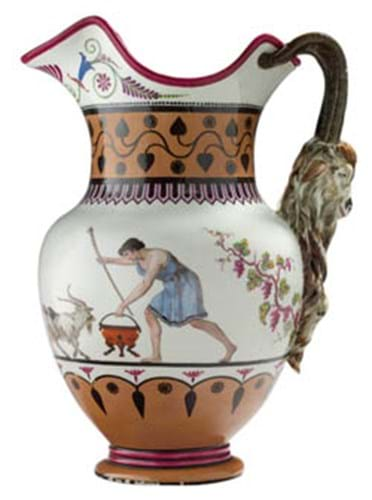
The item in question was a 10in (24.5cm) high jug which showed the Etruscan decoration to great effect.
Entered from a private French source for the sale at the Hotel Drouot on February 11, this rediscovery came with a €200,000-300,000 estimate, but with six bidders contesting it, the price quickly rose beyond that level, halting only when the final two contestants took it to €880,000 (£586,670) plus premium.
The jug itself came from a porcelain service commissioned in 1787-8 from the Royal porcelain factory at Sèvres that was notable for its avant garde design. It was conceived by Jean-Jacques Lagrenée with neoclassical Etruscan-style decoration inspired by recent excavations in Italy rather than the gilded floral sprigs and garlands on coloured grounds for which the factory was already famous.
The service originally comprised 65 pieces, but the whereabouts of only a handful are known today. There is a bowl in the Metropolitan Museum, New York and three pieces in the Musée National de Céramique at Sèvres.
However, the majority of our knowledge of the service comes from Lagrenée's detailed designs preserved in the Sèvres archives.
The commission was originally made after Louis XVI had decided to build his queen, Marie Antoinette, a dairy at his hunting château at Rambouillet in the 1780s - an addition to the famous farm at the Petit Trianon Park in Versailles where she could play at the rustic life.
Under the supervision of the Comte d'Angiviller, the dairy project was managed by Hubert Robert, with an overall decorative theme, which was to be in ultra-fashionable taste.
The jug itself has two banks of orange-red ground painted with stylised palms and flowerheads separate a frieze painted naturalistically with a youth holding a tripod vessel out to a goat and a young woman tending a fruiting vine.
The handle, detailed on the front page, is modelled as a figure of a goat with its horns extending up to the rim to form the grip and painted in trompe l'oeil as if to pierce the neck. Marked with Sèvres crowned interlaced Ls and KK for 1787, it also carries painter's initials of a J or L.
Beyond the high price, further indication of the jug's rarity, and its cultural importance to France, comes from the fact that the auctioneers have announced that the object could become classified as a national treasure within the next few days.




